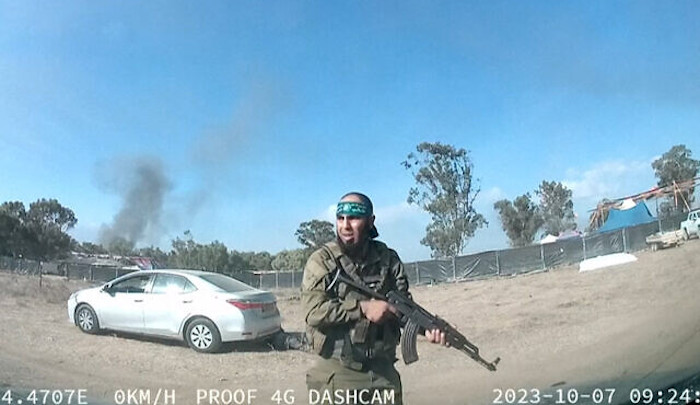In this part we will look at Killing Non-Combatants/Disbelievers, Mutilation, and Burning People Alive.
Killing Non-Combatants/Disbelievers
It is important to note that the distinction between non-combatants and combatants is not found in the doctrines of Islam. Instead, the fundamental distinction is between Muslims (believers) and non-Muslims (disbelievers).
This distinction has been in place since the early days of Islam. According to the commands of Allah in the Koran and teachings of Muhammad, as long as a Muslim remained a Believer and did not violate any of the doctrines of Islam, he was not to be harmed by another Muslim. However, there were three conditions that allowed a Muslim to intentionally kill another Muslim: adultery, apostasy from Islam, and killing another Muslim without legal authority.
With regard to non-Muslims, Muhammad taught that their “blood and property” were not protected from the Muslims unless they converted to Islam:
It has been narrated on the authority of ‘Abdullah b. ‘Umar that the Messenger of Allah said: I have been commanded to fight against people till they testify that there is no god but Allah, and Muhammad is the Messenger of Allah, they establish the prayer, and pay the Zakat. If they do it, their blood and property are guaranteed protection on my behalf except when justified by law, and their affairs rest with Allah.[1]
That non-Muslims were to be fought against and were not protected unless they converted to Islam is openly proclaimed by Allah in Chapter 9, Verse 5 of the Koran; this is the verse referred to by some Muslim scholars as the Verse of the Sword:
Then when the Sacred Months have passed, then kill the Mushrikun [non-Muslims] wherever you find them, and capture them and besiege them, and lie in wait for them in every ambush. But if they repent [by rejecting Shirk (polytheism) and accept Islamic Monotheism] and perform As-Salat (the prayers), and give Zakat (obligatory charity), then leave their way free. Verily, Allah is Oft-Forgiving, Most Merciful.
This command of Allah to kill the Mushrikun was followed during the time of Muhammad as Muslim warriors attacked unsuspecting, non-Muslim communities late at night or early in the morning to the undiscriminating battle cries of Kill! Kill![2] and O victorious one, slay, slay!.[3]
Muhammad even stated that there was to be no penalty for a Muslim who killed a non-Muslim (disbeliever), with no distinction being made between a combatant and a non-combatant:
It was narrated from ‘Amr bin Shu’aib, from his father, from his grandfather that the Messenger of Allah said: “A Muslim should not be killed in retaliation for the murder of a disbeliever.”[4]
And it is significant to note that the Muslim scholar Ibn Kathir said this about that statement by Muhammad:
No opinion that opposes this ruling could stand correct, nor is there an authentic Hadith to contradict it.[5]
During the time of Muhammad there were numerous incidents in which non-Muslims were killed by Muslims, whether they had surrendered after battle or were simply non-combatants.
For example, after the Muslims had emigrated from Mecca to Medina, the first major battle between the Muslims and their Meccan adversaries occurred in March 624 AD: the Battle of Badr. The Meccans were defeated. Among the Meccan captives were a man named Umayya bin Khalaf, and his son. As they were being led away, unarmed, and to be held for future ransom, some of the Muslims recognized Umayya and his son and they killed them both with swords. When Muhammad found out about these killings, he made no objection.[6]
As Muhammad gained power he personally ordered the killing of a number of non-Muslim poets and others who had criticized him and/or Islam (e.g. Ka’b b. al-Ashraf, Abu Rafi’, ‘Asma’ bint Marwan, Abu ‘Afak, and a singing girl named Quraybah).
Muhammad’s attitude and actions were best summed up in a letter written shortly after the Muslim conquest of Mecca in 630 AD. It was sent to a non-Muslim poet who used to satirize Muhammad, from the poet’s brother; here is a portion of that letter:
Allah’s Messenger killed some men in Makkah who used to satirize and harm him, and the poets who survived fled in all directions for their lives. So, if you want to save your skin, hasten to Allah’s Messenger. He never kills those who come to him repenting. If you refuse to do as I say, it is up to you to try to save your skin by any means.[7]
So to save their lives from Muhammad, poets had to flee Mecca.
At one time Muhammad even gave a general order to kill any of the Jews that fell into a Muslim’s hands:
The Messenger of God said, “Whoever of the Jews falls into your hands, kill him.” So Muhayyisah b. Mas’ud [a Muslim warrior] fell upon Ibn Sunaynah, one of the Jewish merchants who was on close terms with them and used to trade with them, and killed him.[8]
And there were examples of individual Muslims taking the initiative to kill non-Muslims for criticizing Muhammad and/or Islam. When Muhammad was told of these, he gave his approval.[9]
And after the defeat of the Jewish Bani Qurayzah tribe, Muhammad supervised the beheading of 600-900 captured males of the tribe. He ordered that all of the males who had reached puberty were to be killed; whether or not they were combatants was irrelevant.[10] Muhammad sent for them and struck off their heads…as they were brought out to him in batches…This went on until the apostle [Muhammad] made an end of them.[11]
Muhammad even specifically ordered that elderly non-Muslims were to be killed:
It was reported from Al-Hasan, from Samurah bin Jundab who said: “The Messenger of Allah said: ‘Kill the old polytheist men, but spare their children.’”[12]
So we can see that Muhammad not only condoned the killing of non-combatant, non-Muslims, he even ordered it at times. The Hamas jihadists were following those orders.
Mutilation
There were multiple reports that the Hamas jihadists mutilated men, women and children. Much of the evidence of this was seen on dead bodies. But for our purposes the issue is, did this mutilation occur while the person was still alive or did it occur after they died? We know of two reports that victims were being mutilated while they were alive:
- “ZAKA personnel reported finding naked, injured women with mutilated sexual organs.”[13]
- “Sapir, a survivor of the Nova festival, describes a rape incident where the terrorists cut off the victim’s breasts followed by cutting her face. With the disfigurement of her face, she collapsed and fell out of Sapir’s sight.”[14]
This is important, because support for the mutilation of the living can be found in the teachings and example of Muhammad.
According to Muhammad, Muslims were not to mutilate dead bodies. Before he sent Muslim forces against non-Muslims, it was reported that he would issue the following order:
… Fight in the name of Allah and in the way of Allah. Fight against those who disbelieve in Allah. Make a holy war…do not mutilate (the dead) bodies…[15]
And on another occasion:
Narrated ‘Abdullah bin Yazid Al-Ansari: The Prophet forbade robbery (taking away what belongs to others by force without their permission), and also forbade the mutilation (or maiming) of bodies.[16]
So when Muhammad talked about forbidding mutilation, he was talking about how dead bodies were to be treated. This understanding that mutilation applied to dead bodies was reiterated by Ibn Hajar, a noted 15th century Islamic scholar, when he explained the meaning of mutilation:
Mutilation means disfigurement of the appearance of a corpse; for example, chopping off limbs for it to be remembered (by the opposition), and the likes.[17]
It should be noted that in Sunan An-Nasa’i we find a hadith stating that:
…The Messenger of Allah used to stress charity in his sermons, and prohibit mutilation.[18]
The modern commentary for this hadith explained:
Mutilation means cutting or tearing off the limbs of the person slain (ear, nose, private parts, etc.) so that the corpse is debased or desecrated.[19]
So Muhammad’s command against mutilation was directed toward how dead bodies were to be treated.
It was another matter for those who were alive.
In Koran 8:12, Allah stated:
(Remember) when your Lord revealed to the angels, “Verily, I am with you, so keep firm those who have believed. I will cast terror into the hearts of those who have disbelieved…smite over all their fingers and toes.”
“Smite over” their fingers and toes means to cut them off. Although this verse states what Allah had commanded the angels to do when they reportedly helped the Muslims during the Battle of Badr, it was also a command for what the Muslims (believers) were to do to their enemies:
Ibn Jarir commented that this Ayah [verse] commands, “O believers! Strike every limb and finger on the hands and feet of your (disbelieving) enemies.”[20]
Why cut off fingers and toes? In the commentary about this verse of the Koran, the modern Tafsir Ahsanul-Bayan explained:
If the fingers of the hands are cut off, they will become unable to move their swords. Similarly, when the toes are cut off, they will be unable to run away.[21]
And for many years Muhammad had a standing order for the mutilation and then killing of a particular non-Muslim:
I have not seen the Messenger of God send an expedition ever, except he said: If you defeat Habbar cut off his hands and legs and then his head.[22]
However, after the conquest of Mecca in January 630, Habbar converted to Islam and was spared by Muhammad.
The mutilation of living people was continued by Abu Bakr, who, after Muhammad died, became the first of the four “Rightly Guided” Caliphs (these first four caliphs were so named because they are believed to have held the most firmly to the teachings of Muhammad):
It is reported that certain women at an-Nujair having rejoiced at the death of the Prophet, abu-Bakr wrote ordering that their hands and feet be cut off. Among these women were ath-Thabja’ al-Hadramiyah, and Hind, daughter of Yamin, the Jewess.[23]
And soon after Muhammad’s death two singing women appeared before Al-Muhajir, the Muslim governor of the Yemen. One of them sang a song reviling Muhammad, and Al-Muhajir had her hand cut off and a front tooth pulled out. Abu Bakr wrote to Al-Muhajir:
Now then: I have learned that you cut off the hand of a woman because she sang satirizing the Muslims, and that you pulled her front tooth. If she was among those who claim (to have embraced) Islam, then (it is) good discipline and a reprimand, and not mutilation.[24]
So we can see that the command of Allah, the teachings and example of Muhammad, and the examples of the first “Rightly Guided” Caliph, make it permissible for Muslims to mutilate those who are still alive. And the HAMAS jihadists did so.
Burning People Alive
There were many reports about finding burned bodies of civilians, some inside burned-down structures. Were they intentionally burned to death?
According to the teachings and example of Muhammad, burning people alive is allowed.
Muhammad considered burning Muslims’ houses down around them to compel their attendance at congregational prayers:
It was narrated that Abu Hurairah said: “The Messenger of Allah said: ‘I was thinking of commanding that the call to prayer be given, then I would tell a man to lead the people in prayer, then I would go out with some other men carrying bundles of wood, and go to people who do not attend the prayer, and burn their houses down around them.’”[25]
In December 627 Muhammad…launched a raid against the tribe of al-Mustalaq and they fought back. So he commanded to set fire to their fortifications all night long with the widespread knowledge that women and children were in there.[26]
In October 630, there was some resistance among the Muslims toward a military expedition Muhammad was planning against the Byzantines at Tabuk. So Muhammad…heard that the hypocrites were assembling in the house of Suwaylim the Jew (his house was by Jasum) keeping men back from the apostle in the raid on Tabuk. So the prophet sent Talha b. ‘Ubaydullah with a number of his friends to them with orders to burn Suwaylim’s house down on them. Talha did so, and al-Dahhak b. Khalifa threw himself from the top of the house and broke his leg, and his friends rushed out and escaped.[27]
Muhammad’s example of being willing to burn people alive continued. After Muhammad died, there were many Arab tribes that left Islam. This resulted in the Wars of Apostasy (Riddah Wars) under Abu Bakr, the first of the four “Rightly Guided” Caliphs. The commander of each army that Abu Bakr sent out had a letter to be read to the tribe before it was attacked. The letter explained that if the tribe did not return to Islam, the army commander…will not spare any one of them he can gain mastery over, [but may] burn them with fire, slaughter them by any means…[28]
The commander of one of the Muslim armies was Khalid bin al-Walid. Here is a command that Abu Bakr gave to Khalid:
…kill them by every means, by fire or whatever else.[29]
And Abu Bakr gave Khalid a specific command when he sent him against the Bani Hanifah in Al-Yamamah:
Kill their wounded, seek out those of them who flee, put the captives among them to the sword and strike terror among them by killing and burn them by fire. And I warn you against contradicting my orders. Peace (be upon you).[30]
Khalid took Abu Bakr’s admonitions to heart and was known for burning many captives alive. Abu Bakr’s response to this was:
I shall not sheathe a sword that Allah had unsheathed against the ‘unbelievers.’[31]
Abu Bakr had even set the example when a captive who had fought against the Muslims was brought to him. Abu Bakr…ordered a fire to be kindled with much firewood in the prayer yard (musalla) of Medina and threw him, with arms and legs bound, into it.[32]
The burning continued as ‘Ali, the fourth “Rightly Guided” Caliph, ordered some people to be burned alive for being hypocrites. A modern commentary explained this decision:
The people, who were burnt alive, were the followers of a Jew named ‘Abdullah bin Sabah. They were hypocrites and they were involved in a heinous crime of preaching ‘Ali’s divinity, so ‘Ali giving a lesson for others, gave them such a severe punishment.[33]
And it is interesting to note that in 2015, the jihadist group ISIS burned alive a captured Jordanian Air Force pilot. Soon afterwards an article appeared in their online magazine Dabiq that included Koran verses, teachings of Muhammad, and examples of Muhammad’s companions to provide the Islamic doctrinal support for the burning alive of “the Jordanian crusader pilot.”[34]
Burning people alive is allowed by Islamic doctrine, and the Hamas jihadists were following that doctrine.
On to Part 3
In Part 3 we will examine the remaining atrocities.
Dr. Stephen M. Kirby is the author of six books about Islam. His latest book is Islamic Doctrine versus the U.S. Constitution: The Dilemma for Muslim Public Officials.
[1] Sahih Muslim, Vol. 1, No. 22, pp. 21-22.
[2] E.g.,; The Life of Muhammad: Al-Waqidi’s Kitab al-Maghazi, p. 355; Sunan Abu Dawud, Vol. 3, No. 2638, pp. 275-276; Abu Ja’far Muhammad b. Jarir al-Tabari, The History of al-Tabari: The Victory of Islam, Vol. VIII, trans. and annotated Michael Fishbein (Albany, New York: State University of New York Press, 1997), p. 142; and Abu ‘Abd Allah Muhammad ibn Sa’d ibn Mani’ al-Zuhri al-Basri, Kitab al-Tabaqat al-Kabir, 2 Volumes, trans. S. Moinul Haq (New Delhi, India: Kitab Bhavan, 2009), Vol. 2, p. 146.
[3] E.g., The Life of Muhammad (Sirat Rasul Allah), n. 738, p. 768, and n. 760, p. 770; The Life of Muhammad: Al-Waqidi’s Kitab al-Maghazi, p. 549; and Kitab al-Tabaqat al-Kabir, Vol. 2, p. 237.
[4] Sunan Ibn Majah, Vol. 3, No. 2659, p. 528.
[5] Tafsir Ibn Kathir, Vol. 1, p. 485. The significance of Ibn Kathir’s statement lies in the fact that his commentaries are still considered authoritative today. In the publisher’s comments in 2000 for the ten volume English translation of Ibn Kathir’s commentaries, it was pointed out that this collection is the most popular interpretation of the Qur’an in the Arabic language, and the majority of the Muslims consider it to be the best source based on Qur’an and Sunnah.
Tafsir Ibn Kathir, Vol. 1, p. 5.
[6] Essay Regarding the Basic Rule of the Blood, Wealth and Honour of the Disbelievers, At-Tibyan Publications, August 22, 2004, p. 24.
[7] Safiur-Rahman al-Mubarakpuri, The Sealed Nectar (Riyadh, Kingdom of Saudi Arabia: Darussalam, 2008), p. 521.
[8] Abu Ja’far Muhammad b. Jarir al-Tabari, The History of al-Tabari: The Foundation of the Community, Vol. VII, trans. M. V. McDonald and annotated W. Montgomery Watt (Albany, New York: State University of New York Press, 1987), p. 97.
[9] 1) A Muslim stabbed to death his pregnant female slave: Sunan Abu Dawud, Vol. 5, No. 4361, pp. 20-21; and Abu ‘Abdur-Rahman Ahmad bin Shu’aib bin ‘Ali bin Sinan bin Bahr An-Nasa’i, Sunan An-Nasa’i, trans. Nasiruddin al-Khattab (Riyadh, Kingdom of Saudi Arabia: Darussalam, 2007), Vol. 5, No. 4075, pp. 66-67. 2) A Muslim strangled a Jewish woman: Sunan Abu Dawud, Vol. 5, No. 4362, p. 21. 3) A Muslim killed a man who said he did not believe in Islam and would never become a Muslim: The History of al-Tabari: The Foundation of the Community, pp. 149-150.
[10] The History of al-Tabari: The Victory of Islam, p. 38.
[11] The Life of Muhammad (Sirat Rasul Allah), p. 464.
[12] Sunan Abu Dawud, Vol. 3, No. 2670, p. 296. A variation of this, specifying pre-pubescent boys instead of children in general, was reported in Jami’ At-Tirmidhi:
Samurah bin Jundab narrated that the Messenger of Allah said: “Kill the elder men among the idolaters and spare the Sharkh among them.”
Jami’ At-Tirmidhi, Vol. 3, No. 1583, p. 353. The commentary for this hadith noted that “the Sharkh are the boys who did not begin to grow public hair.”
[13] “Silent Cry, Sexual Crimes in the October 7 War,” The Association of Rape Crisis Centers in Israel, February 2024, p. 27, https://acrobat.adobe.com/id/urn:aaid:sc:VA6C2:f3c818f3-d9c2-4175-8459-4076c0714374.
[14] Ibid., p. 30.
[15] Sahih Muslim, Vol. 5, No. 1731R1, p. 163. A second version of this hadith reported that Muhammad said, “…do not mutilate (the dead enemy)…”; see Sunan Abu Dawud, Vol. 3, No. 2613, p. 264.
[16] Sahih Al-Bukhari, Vol. 3, Book 46, No. 2474, p. 380.
[17] The Clarification Regarding Intentionally Targetting Women and Children, p. 52.
[18] Sunan An-Nasa’i, Vol. 5, No. 4052, p. 56.
[19] Ibid.
[20] Tafsir Ibn Kathir, Vol. 4, p. 274.
[21] Tafsir Ahsanul-Bayan, Vol. 2, Commentary No. 2, p. 276.
[22] The Life of Muhammad: Al-Waqidi’s Kitab al-Maghazi, p. 422.
[23] Ahmad ibn Yahya ibn Jabir al-Baladhuri, The Origins of the Islamic State, Being a Translation from the Arabic, Accompanied with Annotations, Geographic and Historic Notes of the Kitab Fituh Al-Buldan of Al-Imam Abu-L Abbas Ahmad Ibn-Jabir Al-Baladhuri, trans. Philip Khuri Hitti (1916; rpt. Lexington, Kentucky: Ulan Press, 2014), p. 155.
[24] Abu Ja’far Muhammad b. Jarir al-Tabari, The History of al-Tabari: The Conquest of Arabia, Vol. X, trans. and annotated Fred M. Donner (Albany, New York: State University of New York Press, 1993), pp. 191-192.
[25] Sunan Ibn Majah, Vol. 1, No. 791, pp. 513-514.
[26] The Al Qaeda Reader, trans. and ed. Raymond Ibrahim, (New York: Broadway Books, 2007), p. 167.
[27] The Life of Muhammad (Sirat Rasul Allah), n. 858, p. 782.
[28] The History of al-Tabari: The Conquest of Arabia, p. 57.
[29] Ibid., p. 100.
[30] Muhammad ibn ‘Abdul Wahhab at-Tamimi, Abridged Biography of Prophet Muhammad, ed. ‘Abdur-Rahman bin Nasir Al-Barrak, ‘Abdul ‘Azeez bin ‘Abdullah Ar-Rajihi, and Muhammad Al-‘Ali Al-Barrak (Riyadh, Kingdom of Saudi Arabia: Darussalam, 2003), p. 345.
[31] The Origins of the Islamic State, p. 148.
[32] The History of al-Tabari: The Conquest of Arabia, p. 80.
[33] Jami’ At-Tirmidhi, Vol. 3, Comments to Hadith No. 1458, p. 244.
[34] See “The Burning of the Murtadd Pilot,” Dabiq, Issue 7, February 2015, p. 5, https://islamseries.files.wordpress.com/2019/08/dabiq-issue-7-february-2015.pdf.



















[…] Read Part 1 here! Read Part 2 here! […]